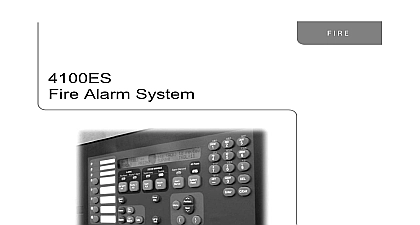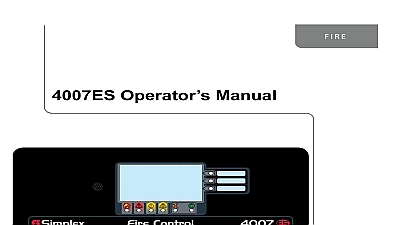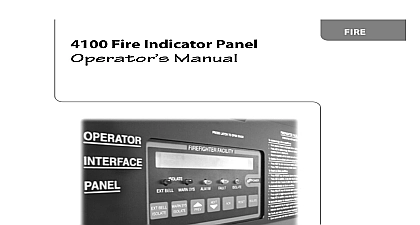Simplex InfoAlarm Operator’s Manual

File Preview
Click below to download for free
Click below to download for free
File Data
| Name | simplex-infoalarm-operator-s-manual-5074218936.pdf |
|---|---|
| Type | |
| Size | 1.93 MB |
| Downloads |
Text Preview
Operator Manual InfoAlarm 4100U 4100ES B and Warnings AND SAVE THESE INSTRUCTIONS Follow the instructions in this installation manual These instructions must be followed to damage to this product and associated equipment Product operation and reliability depend upon proper installation NOT INSTALL ANY SIMPLEX PRODUCT THAT APPEARS DAMAGED Upon unpacking your Simplex product inspect contents of the carton for shipping damage If damage is apparent immediately file a claim with the carrier and notify an authorized Sim product supplier HAZARD Disconnect electrical field power when making any internal adjustments or repairs All repairs should be per by a representative or authorized agent of your local Simplex product supplier HAZARD Static electricity can damage components Handle as follows Ground yourself before opening or installing components Prior to installation keep components wrapped in anti static material at all times SAFETY HAZARD Under certain fiber optic application conditions the optical output of this device may exceed eye safety limits not use magnification such as a microscope or other focusing equipment when viewing the output of this device RULES AND REGULATIONS PART 15 This equipment has been tested and found to comply with the limits for a Class A digital device pursuant Part 15 of the FCC Rules These limits are designed to provide reasonable protection against harmful interference when the equipment is operated in a com environment This equipment generates uses and can radiate radio frequency energy and if not installed and used in accordance with the instruction may cause harmful interference to radio communications Operation of this equipment in a residential area is likely to cause harmful interference in case the user will be required to correct the interference at his own expense REACCEPTANCE TEST AFTER SOFTWARE CHANGES To ensure proper system operation this product must be tested in accordance NFPA 72 after any programming operation or change in site specific software Reacceptance testing is required after any change addition or deletion of components or after any modification repair or adjustment to system hardware or wiring components circuits system operations or software functions known to be affected by a change must be 100 tested In addition to ensure that other oper are not inadvertently affected at least 10 of initiating devices that are not directly affected by the change up to a maximum of 50 devices must also be and proper system operation verified and Trademarks 2006 2011 SimplexGrinnell LP All rights reserved and other information shown were current as of publication and are subject to without notice and the Simplex logo are trademarks of Tyco International Ltd and its affiliates and are under license of Contents and Warnings iv and Trademarks iv to Use this Publication ix ix Conventions ix User Interface Conventions ix 1 Basic Concepts and Operations 1 1 1 1 this Chapter 1 1 System Description 1 2 1 2 Appearance of Operator Interface Panel 1 4 1 4 2 Alarm Conditions 2 1 2 1 this Chapter 2 1 an Alarm 2 2 the FACP Indicates that an Alarm has Occurred 2 2 Acknowledging an Alarm 2 5 Acknowledging Alarms 2 5 Acknowledging Alarms 2 6 an Alarm 2 7 2 7 the Alarm Silence Key 2 8 the System 2 9 2 9 a System with Active Alarms 2 9 a Hardware Reset 2 10 3 Trouble Conditions 3 1 3 1 this Chapter 3 1 3 2 the FACP Indicates the Presence of a Trouble 3 2 an Acknowledge Does 3 2 Troubles 3 3 Acknowledging Troubles 3 3 Acknowledging Troubles 3 4 the Trouble Doesn Clear 3 5 3 5 Reset Key 3 5 Conditions 3 6 Indications for TrueAlarm Sensors 3 6 to Do when TrueAlarm Troubles Occur 3 6 4 Supervisory Conditions 4 1 4 1 this Chapter 4 1 4 2 the FACP Indicates the Presence of a Supervisory Condition 4 2 Supervisory Conditions 4 3 Acknowledge Does 4 3 Acknowledging Supervisory Conditions 4 3 Acknowleding Supervisory Conditions 4 4 5 Selecting Points for Status and Control 5 1 5 1 this Chapter 5 1 Points from Alarm Trouble Supervisory List 5 2 5 2 Points with the Entry Keypad 5 3 5 3 Point Call up Screen Options 5 4 6 Advanced Functions 6 1 6 1 this Chapter 6 1 In and Out of the System 6 2 6 2


